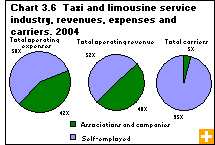Common menu bar links
Making a living on the road
Archived Content
Information identified as archived is provided for reference, research or recordkeeping purposes. It is not subject to the Government of Canada Web Standards and has not been altered or updated since it was archived. Please contact us to request a format other than those available.
Canada’s taxi and limousine drivers perform a crucial service. They take us across a congested city to a meeting, drive us to the airport, chauffeur our friends and family in style to graduations and weddings and get us home safely after a night on the town.
Taxi and limousine companies generated $1.3 billion in fares and other revenue in 2004, only slightly more than in the previous year, but 27% more than in 2000. Those who make their living on the road are particularly vulnerable to the price of fuel. Higher fuel costs in 2004 meant that operating expenses climbed faster than revenues. As a result, taxi and limousine services saw their operating margins shrink by about 4% from 2003.
The roughly 35,300 taxi and limousine firms are divided into two major categories: associations and companies, and self-employed drivers. A small number of associations and companies—about 5% of all businesses in the industry—generate about 42% of the operating revenues. The more than 33,500 self-employed drivers, 95% of the industry, are responsible for the remaining 58%.
The larger companies operate on slim profit margins. In 2004, the operating revenue of taxi and limousine associations and companies was $530.3 million. Operating expenses consumed $523.6 million, leaving a profit margin of 3%. One-third of these expenses went to paying salaries, wages and benefits.
Self-employed drivers’ operating revenues totalled $735.0 million and their expenses were $557.9 million, for a profit margin of 25%. Their profit margin is higher because they often report it as personal income.



